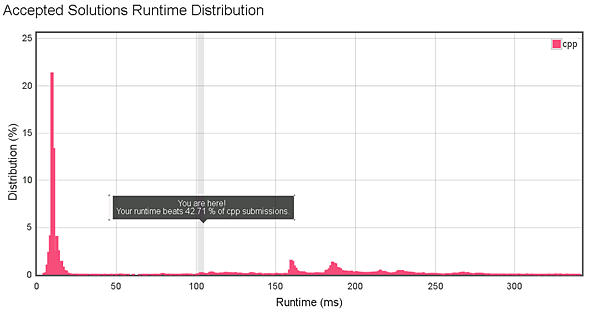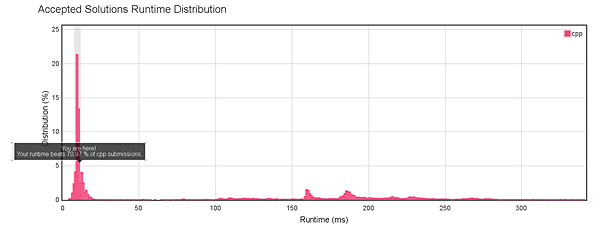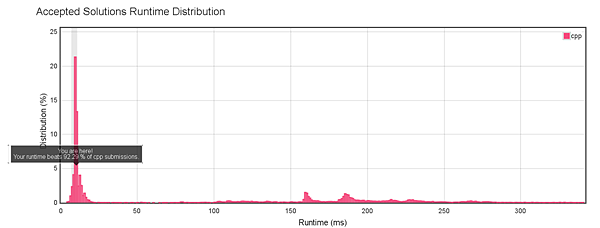Leetcoode其實一直有在寫,只是每次寫了過一段時間又會覺得不踏實,藉此乾脆弄一個部落格,把解題的心得與過程記錄下來以備不時之需
Given an array of integers, return indices of the two numbers such that they add up to a specific target.
You may assume that each input would have exactly one solution, and you may not use the same element twice.
Example:
Given nums = [2, 7, 11, 15], target = 9, Because nums[0] + nums[1] = 2 + 7 = 9, return [0, 1].
養成好的習慣,在寫程式前先寫好測試單元。
簡單的寫了一個struct來讓測試比較好運行
struct TestData {
std::vector<int> ques; // 欲尋找的陣列,如上述的Example的話就是 [2, 7, 11, 15 ]
int target;
std::vector<int> ans; // 預期答案
};
設計了幾個測試case如下:
- 一般功能的測試: { { 2,7,11,0,10 }, 9, { 0,1 } }
- target為負的情況: { { -2,-7,11,0,-3,10 }, -10, { 1, 4 } }
- 欲查詢的陣列需要相同的元素來組成目標時{ { 2,7,11,0,10,0 }, 0, { 3,5 } }
- tartget需要正負的兩個元素所組成{ { -2,7,11,0,1,10 }, -1, { 0,4 } }
運行單元測試的內容如下:
int main(){
// 單元測試集合
std::vector TestSet = {
{ { 2,7,11,0,10 },9,{ 0,1 } },
{ { -2,-7,11,0,-3,10 },-10,{ 1, 4 } },
{ { 2,7,11,0,10,0 },0,{ 3,5 } },
{ { -2,7,11,0,1,10 },-1,{ 0,4 } }
};
Solution s;
// 尋遍各個測試單元並驗證是否相同
for (int32_t i = 0; i < TestSet.size(); i++) {
if (TestSet[i].ans != s.twoSum(TestSet[i].ques, TestSet[i].target)) {
return false;
}
}
return true;
}
直覺的解題邏輯與步驟是,
- 尋遍欲查詢的陣列並做下面這件事情
- 將target 減去當前元素的值
- 查找陣列中是否有與減去後相同的元素
- 若有則返回當前元素與找到的元素索引
class Solution {
public:
std::vector<int> twoSum(std::vector<int>& nums, int target) {
std::vector<int>::iterator it;
// 尋遍整個陣列
for (int i = 0; i < nums.size(); i++) {
// 查找target - 當前元素值並使用find來尋找相同元素
it = find(nums.begin(), nums.end(), target - nums[i]);
// 如果有則返回
if (it != nums.end()) {
std::vector<int> ans;
// 當前的索引
ans.push_back(i);
// 找到的另一個索引
ptrdiff_t pos = it - nums.begin();
ans.push_back(pos);
return ans;
}
}
}
};第一次的寫出來的解法如下
但在執行測試單元後就會發現在第三個測試單元中就會失敗
3.欲查詢的陣列需要相同的元素來組成目標時{ { 2,7,11,0,10,0 }, 0, { 3,5 } }他回傳了{3, 3 }這個答案 ( 幸好有寫單元測試)
那麼將答案改過之後變成
class Solution {
public:
std::vector twoSum(std::vector& nums, int target) {
std::vector::iterator it;
// 尋遍整個陣列
for (int i = 0; i < nums.size(); i++) {
// 查找target - 當前元素值並使用find來尋找相同元素
it = find(nums.begin() + i + 1, nums.end(), target - nums[i]);
// 如果有則返回
if (it != nums.end()) {
std::vector ans;
// 當前的索引
ans.push_back(i);
// 找到的另一個索引
ptrdiff_t pos = it - nums.begin();
ans.push_back(pos);
return ans;
}
}
}
};
測試單元都有通過了,那麼把答案提交看看吧!因該還有進步的空間。

果然沒猜錯,在執行速率上被一堆人打趴!果然功力還有差。
經過一個小時的苦思,有想到一個降低時間複雜度的方式。
基本的思路是「將查找的動作換成hash table」:
步驟大致如下:
1.先用一個迴圈建立hash_table
但在第三個測試項目中產生衝突:
因為是用迴圈建立的,所以如果KEY發生衝突會以最後一個相同的KEY找到的元素為value
雖然在這個題目上應該是沒有問題的,待會再來處理這個情況。
2.利用target-當前元素去查找
所以經過修改後解答變成這樣
class Solution {
public:
vector twoSum(vector& nums, int target) {
std::map m;
for (int i = 0; i < nums.size(); i++) {
m[nums[i]] = i;
}
std::map::iterator it;
for (int i = 0; i < nums.size(); i++) {
it=m.find(target - nums[i]);
if (it != m.end() && it->second!=i) {
std::vector ans = { i, it->second};
return ans;
}
}
}
};好那麼將答案提交看看

OK! 果然有顯著的提升,但還是有進步的空間。
好的,看看還有什麼地方可以加快的,
「是不是可以把兩個迴圈寫成一個!!??」
class Solution {
public:
vector twoSum(vector& nums, int target) {
std::map m;
std::map::iterator it;
for (int i = 0; i < nums.size(); i++) {
it = m.find(target - nums[i]);
if (it != m.end() && it->second != i) {
std::vector ans = { it->second ,i};
return ans;
}
m[nums[i]] = i;
}
}
};這樣應該是最快了吧!!
興奮的提交答案後

果然有再提升一點速度,呼解到這邊我已經滿足了。這題就先這樣吧


 留言列表
留言列表


